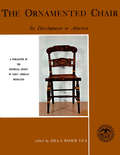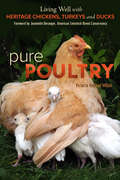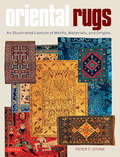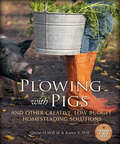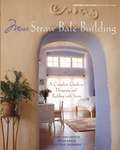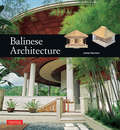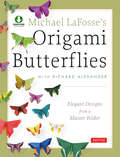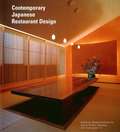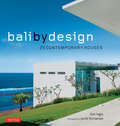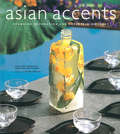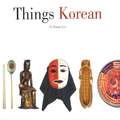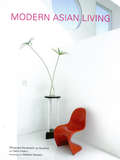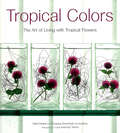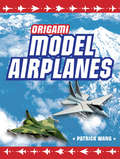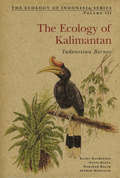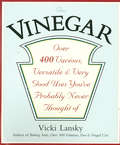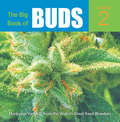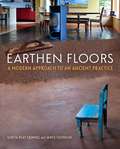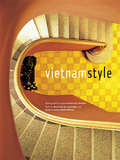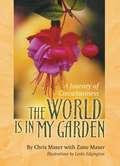- Table View
- List View
The Ornamented Chair
by Zilla Rider LeaDiscriminating decorators and collectors, no less than dealers and researchers in antiques, have long felt the need of a comprehensive study of the ornamented chair and its development in America. This book is the product of an effort to satisfy that need and at the same time to bring new pleasures to lovers of beautiful furniture.The book is based on photographic and research material collected by the late Esther Stevens Brazer, who spent a lifetime in the study and revival of early American decoration.The authors are all qualified researchers, teachers, and decorators. In their text they present a general history of chair types, facts regarding ornamentation, and informative accounts of some of the leading craftsmen and decorators of the various periods. The final chapter of the book briefly relates the history of the Society and describes how its members carry forward the efforts of Esther Stevens Brazer, maintaining in their research, their teaching, and their restorations the standards of an old craft and the traditions of its finest workmen.
Pure Poultry
by Victoria Redhed MillerPure Poultry is a timely resource for new and experienced poultry keepers who want to raise heritage breeds as an integral part of a more sustainable food system. This inspiring "how-to and why-to" guide combines revealing and often humorous anecdotes with detailed information on everything from housing, breeding and day-to-day care, to cooking and food preservation.
Quiet Beauty
by Kendall H. Brown David M. CobbQuiet Beauty: Japanese Gardens of North America is an extraordinary look at the most beautiful-and serene-gardens in the United States and Canada. Most Japanese garden books look to the gardens of Japan. Quiet Beauty explores the treasure trove of Japanese gardens located in North America. Featuring an intimate look at twenty-six gardens, with numerous stunning color photographs of each, that detail their style, history, and special functions, this book explores the ingenuity and range of Japanese landscaping.Gardens include: Japanese Tea Garden in Golden Gate Park, San Francisco, California Nitobe Memorial Garden, University of British Columbia, Vancouver, British Columbia Japanese Garden, Fort Worth Botanic Garden, Texas Garden of the Pine Winds, Denver Botanic Gardena, Colorado Japanese Garden, Montréal Botanical Garden, Québec Tenshin'en (The Garden of the Heart of Heaven), Museum of Fine Arts, Boston, Massachusetts Roji'en (Garden of Drops of Dew), The George D. and Harriet W. Cornell Japanese Gardens, The Morikami Museum and Japanese Gardens, Delray Beach, Florida Japanese Friendship Garden of Phoenix, Margaret T. Hance Park, Arizona Garden of the Pine Wind, Garven Woodland Garden, Hot Springs, Arkansas
Oriental Rugs
by Peter F. StoneThis monumental reference work--long awaited by collectors and scholars--fills an important gap in the available literature on oriental rugs. Lavishly illustrated with over 1000 photographs and drawings, it offers clear and precise definitions for the rug and textile terms in use across a broad swath of the globe--from Morocco to Turkey, Persia, the Caucasus region, Central Asia, Afghanistan, Pakistan, India and China. Covering priceless museum-quality rug traditions as well as modern centers of production, Oriental Rugs draws on classical scholarship as well as current terminology in use among producers and traders in these areas today. It focuses primarily on the rich hand-knotting and hand-weaving traditions of the Near East and Central Asia, but also includes some examples of Scandinavian and Native American weavings.Rugs are receiving ever-increasing attention and recognition in the field of art history. Tribal weavings especially have become a focus for new research, and Oriental Rugs provides a new understanding of many distinctive traditions that were previously understudied, such as the weavings of southwest Persia, Baluchistan and Kurdistan. A concise reference, this volume is a must-have for serious collectors and scholars.
Plowing with Pigs and Other Creative, Low-Budget Homesteading Solutions
by Karen K. Will Oscar H. WillFueled by a failing economy and a passionate desire for a return to simpler times, a new wave of homesteaders is seeking the good life and the kind of true satisfaction that can only be built, not bought. Many of these modern pioneers are cash poor, but rich in energy and creativity. Plowing with Pigs and Other Creative, Low-Budget Homesteading Solutions offers them a set of fresh ideas for achieving independence through sweat equity and the use of unconventional resources. This highly readable and entertaining guide brings together answers to common problems faced by homesteaders young and old, urban, suburban, and rural. Traditional knowledge is combined with MacGyver-style ingenuity to create projects that maximize available resources, including: Animal management strategies for the yard, garden, and field Pole building and construction techniques from woodlot materials Replacing farm machinery with homemade hand tools and implements Leveraging increased self-sufficiency into a home-based business Whether you are a dreamer or a doer, Plowing with Pigs will inspire, challenge, and enable you to do more with less (and have fun doing it). Oscar H. (Hank) Will III is a farmer, scientist, and author, known for seeking and implementing creative farmstead solutions. The editor of Grit magazine, Hank has published hundreds of articles and five books on a range of topics including antique farm machinery. Karen K. Will is editor of The Heirloom Gardener magazine and author of Cooking with Heirlooms: Seasonal Recipes with Heritage-Variety Vegetables and Fruits. She operates Prairie Turnip Farm with her husband Oscar H. Will III.
More Straw Bale Building
by Peter Mack Chris MagwoodStraw bale houses are easy to build, affordable, super energy efficient, environmentally friendly, attractive, and can be designed to match the builder's personal space needs, esthetics and budget. Despite mushrooming interest in the technique, however, most straw bale books focus on "selling" the dream of straw bale building, but don't adequately address the most critical issues faced by bale house builders. Moreover, since many developments in this field are recent, few books are completely up to date with the latest techniques.More Straw Bale Building is designed to fill this gap. A completely rewritten edition of the 20,000-copy best--selling original, it leads the potential builder through the entire process of building a bale structure, tackling all the practical issues: finding and choosing bales; developing sound building plans; roofing; electrical, plumbing, and heating systems; building code compliance; and special concerns for builders in northern climates. New material includes:more extensive sections on electric wiring and plumbingupdated sections on bale finishes and finishinga section on prefabricated straw bale wallsa wider selection of case studies, photographs and illustrationsa section on common mistakesbudgeting for low-, medium- and high-cost projects, and new testing data that is in no other straw bale book.Down-to earth and complete, More Straw Bale Building makes the remarkable benefits of straw bale building available in the most comprehensive and practical book on the subject to date.Chris Magwood and Peter Mack are professional straw bale house builders and consultants who have constructed over 40 straw bale structures and have taught workshops and seminars in several countries. Chris is editor of The Last Straw Journal, an international quarterly devoted to straw-bale building, and the coauthor of Straw Bale Details: A Manual for Designers and Builders (New Society Publishers, 2003).
Balinese Architecture
by Luca Invernizzi Tettoni Bruce Granquist Davison Julian Nengah Enu Mubinas HanafiBalinese style villas and resorts are popping up everywhere-from Ibiza to St Barts to Singapore. But what is Balinese architecture? And why is it so popular today?Traditional Balinese houses, temples and pavilions are designed to allow man to exist in harmony with the natural forces of the universe-reflecting core Balinese beliefs about man's place in relation to the cosmos, the gods, the ancestors, and the world around him. Innovative local and Western architects have been designing resorts and villas on Bali for decades, drawing their inspiration from these local traditions.In this one-of-a-kind book, author Julian Davison provides a comprehensive guide to Balinese architectural forms, the Balinese belief system, the rituals associated with building, the materials and construction techniques, and the intricate ornamentation used. Over 100 watercolor illustrations and photographs provide a clear picture of the island's architecture as well as an eye-opening look at a culture and a people that have captivated the world's imagination.
Michael LaFosse's Origami Butterflies
by Richard L. Alexander Michael G. LafosseWhimsical, exquisite and fragile, butterflies and moths have enchanted and inspired people for centuries. Origami artist Michael G. LaFosse is no exception. His original butterfly paper-folding techniques are a dramatic new development in origami-which some have hailed as the most important advance in origami since the first paper cranes appeared centuries ago. Hundreds of LaFosse butterflies have been featured in exhibitions around the world and his iconic designs are now eagerly sought and widely imitated by folding enthusiasts everywhere.Michael LaFosse's Origami Butterflies presents 26 original projects from LaFosse's extensive butterfly and moth repertoire, including all his personal favorites. This collection has many rarely-seen designs, and several of the models illustrate new technical and design achievements made possible by the ingenious "LaFosse Origami Butterfly Folding System."These elegant forms-each created from a single square sheet of paper without cutting or glue-showcase the versatility of the folding system. All are deceptively simple, yet provide a solid foundation for creative flights of fancy in the hands of an experienced folder. Clear step-by-step instructions show you how to make literally hundreds of different variations by making small adjustments to a few key folds! Whether dry-folded from recycled candy wrappers or wet-folded from expensive handmade papers, these designs exemplify the best aspects of the paper folder's art today.This exciting new book with accompanying DVD represents the culmination of a lifetime of designing and perfecting the art of origami butterflies. It contains everything you need to create your own unique collection!Butterflies include:A Butterfly for Vanessa GouldThe Butterfly for Robert LangA Butterfly for Eric JoiselA Swallowtail for Guy KawasakiThe Boston ButterflyThe Mudarri Luna Moth
Island Style
by Jacob Termansen Gillian BealFrom medieval times, travelers have returned from the East bringing designs, artifacts and architectural ideas with them. The Indonesian archipelago - with its myriad peoples, cultures, and arts and crafts traditions - has long been a source of particular inspiration, Now many are choosing to stay there(or indeed are returning home) and building dream retreats in their natural tropical settings. Island Style showcases over 25 such dwellings - be they private homes, resort villas or island hideaways all harness Indonesia's unique architectural and design ethos and meld it with Western aesthetics. Simple yet exotic, clean lined and contemporary, metropolitan or in more remote locations. In addition, there are plenty of practical design ideas for interiors, doorways, walls, furnishings, furniture and lighting. Photographed entirely on location, Island Style showcases the application of Eastern ideals in any global setting.
Contemporary Japanese Restaurant Design
by Nacass Partners Motoko Jitsukawa Cornucopia K K.With evocative texts accompanying stunning photographs, Contemporary Japanese Restaurant Design features 28 of the most cutting-edge dining spaces by the country's leading restaurant designers.
Bali By Design
by Jacob Termansen Kim Inglis[Bali has long been a creative inspiration for the world-providing exciting new design ideas that are emulated today in homes and hotels around the globe.] The open to the elements bathroom with interior courtyard garden, the giant bamboo sofa with handwoven cushion covers, and the garden pavilion or balé with raised platform seating are all examples of concepts that originated on the island.All these-and much more-may be viewed in [Bali By Design provides coverage of the latest and best design work in Bali today. Featuring 25 stunning contemporary homes, it showcases the ideas of a new generation of talented international and Indonesian designers.] Each of these extraordinary houses presents new solutions for age-old challenges-illustrating how stylish modern lifestyles may be achieved through clever architecture and interior design. See the selection of artful furniture and furnishings in open, airy rooms, the inclusion of natural stone in shady courtyards and swimming pools, and the plethora of handcrafted surfaces, objects and artifacts.[Many of these houses explore ways of reducing power consumption for a more sustainable, low-carbon future. Others present a modern urban version of the tropical Bali design style that has its roots in a traditional rural environment. All, however, combine modern technology with exotic local materials-Balinese sandstone, volcanic rock, recycled ulin wood-for breezy indoor-outdoor living.With over 300 stunning photographs by Danish photographer Jacob Termansen and an insightful text by British author Kim Inglis, this book is a fitting testament to the originality and talent of Bali's design world.]
Asian Accents
by Peter Mealin Martyne Kupciunas Lisa Kim-TribolatiAsian Accents fuses an Eastern tradition of serenity and balance with a Western sense of fun and curiosity. Experience the diversity and richness of Asian culture and welcome the exotic furnishings, textiles and flavors of Asia into your home.From casual cocktails by the pool to sophisticated dinners Asian Accents presents tips and ideas for a variety of special occasions, stunningly photographed in eleven beautiful homes, where food and decor complement each other perfectly
Things Korean
by O-Young Lee John HolsteinThings Korean is a useful guide to traditional life in Korea, presented in an accessible and attractive format. O-Young Lee, former Korean Minister of Culture gives us a survey of native objects from Korea, from totems(Changsung) to hair-pins(binyo), crock pots(Changdokdae) to temple bells(Jong), scissors(Kawi) to graves(mudon) explaining their significance and place in everyday Korean life.Each item in the book is listed under its English and Korean name; a glossary is provided to further assist the reader. Lavishly illustrated with more than 100 color illustrations, Things Korean is a magnificent celebration of Korean culture.
Modern Asian Living
by Masano Kawana Sakul Intakul Wongvipa Devahastin Na AyudhyaIn recent years Asian design - in architecture, interiors and product design - has catapulted on to the global stage. Gone are the thatched villas and vernacular furniture of yesteryear. Replacing them are sleek, modern spaces, decked out with high quality furnishings and furniture, beautiful artworks ans state-of the-art technology. This book showcases a number of brand new properties - be they shops, homes, holiday houses, restaurants, bars of offices - that represent this new wave of Asian talent.
Japanese Garden Design
by Marc P. Keane Haruzo OhashiThe creation of a Japanese garden combines respect for nature with adherence to simple principles of aesthetics and structure. In Japanese Garden Design, landscape architect Marc Peter Keane presents the history and development of the classical metaphors that underlie all Japanese gardens.Keane describes the influences of Confucian, Shinto and Buddhist principles that have linked poetry and philosophy to the tangible metaphor of the garden. Detailed explanations of basic design concepts identify and interpret the symbolism of various garden forms and demonstrate these principles in use today.
Tropical Colors
by Luca Invernizzi Tettoni Sakul Intakul Wongvipa Devahastin Na Ayudhya[In this stunning book, renowned Thai floral artist Sakul Intakul combines colorful tropical flowers, exotic foliage and other unusual design materials in refreshingly original floral displays suitable for any occasion and any setting. Photographed in the spectacular, contemporary homes of Thailand's leading artists, designers and professionals, the simple but imaginative floral displays evoke the essence of a modern Asian style.]This refreshingly original book goes beyond the everyday-elevating tropical flowers from mere floral arrangements to meditative floral "art installations" that serve as dramatic design centerpieces in contemporary tropical homes. Created from a combination of exotic and colorful tropical flowers, plant materials-fibers and leaves from the banana and coconut, twigs from the bamboo-and other less orthodox materials like wire netting, the arrangements harmoniously blend a strong, usually three-dimensional structure with the sweet and subtle elements of flowers. Allow Tropical Colors to inspire you, adding a gorgeous Asian flair to your home!
Origami Model Airplanes
by Patrick WangNow you can create amazingly detailed model airplanes using basic origami techniques! Have you ever marveled at the intricate design work of a model plane? Or dreamed about making one, but been intimidated by the long and complicated directions? If so, then Origami Model Airplanes is the book for you!Expert folder Patrick Wang provides illustrated instructions for 23 original paper airplanes. Not only has he created designs for truly eye-catching paper planes, he's also devised a unique system for making them that is less time consuming and frustrating, even for absolute newcomers to the art of paperfolding. Experienced folders will marvel that the most realistic model airplanes available today can be made using just familiar origami methods. In addition to multiple photos of the finished fighter jet models and other military planes, numerous facts are given for each of the planes these models so realistically depict.Take a chance with Origami Model Airplanes and prepare to stupefy and impress all who see them. No one will ever believe these intricate-looking model airplanes take just a nimble set of fingers, a pair of scissors and a bit of glue to make.
The Ecology of Kalimantan
by Arthur Mangalik Kathy Mackinnon Hakimah Halim Gusti HattaThe Ecology of Kalimantan starts by examining each of the major ecosystems in Kalimantan and the interrelationships of some of the component species. The book takes a look at Bornean peoples, describing their traditional attitudes to and relationships with their forest environment. The book then examines the potential of different land units for the development of artificial production systems such as agricultural cropping, plantations, and agroforestry, and the development options open for forests, wetlands and coastal resources.
Vinegar
by Vicki Lansky Martha CampbellThis collection of useful recipes, cleaning concepts and tips is full of ideas that have worked for others and will work for you. Whimsical line drawings by illustrator, Martha Campbell add a humorous touch to this wonderful addition of a home reference bookshelf filled with books by Vicki Lansky.A bit if history about, wonderful recipes for, and a lot of amazing uses for--VINEGAR are in this 7" x 6" trade paperback. One hundred and twenty pages fill this fun and practical compendium. In ten different chapters, ranging from cooking to cleaning to hygiene and home remedies, you'll find that vinegar also works as a diet aid, stain remover, condiment, odor eater, grooming aid, preservative and cleaner.
Baking Soda
by Vicki Lansky Martha CampbellThis 7" x 6", 120 page book is fully indexed. Learn how baking soda was developed into a consumer product, how it works, and more importantly how to use it in an amazing number of ways. In fifteen different catagories, ranging from cooking and cleaning to hygience and home remedies, you'll find ideas you never thought of. Baking soda can be used for cooking, laundry, gardening, skin solutions, kitchen clean up, dental care, caring for kids, crafts and hobbies, bathroom clean up, grooming, pet problems, cars, and camping to name a few.
The Big Book of Buds
by Ed RosenthalThe Big Book of Buds Volume 2 continues in the tradition of its predecessor by combining stunning, full-color photography with fun and clear descriptions of the characteristics that any gardener or connoisseur wants to know. With no strains repeated from Volume 1, this second volume supplements the first Big Book of Buds with another 100 of the latest and greatest marijuana strains commercially available in the world today.No other book brings together as much information for choosing or identifying specific marijuana strains. Each variety is described with quick reference icons for immediate overview and sorting. An engaging text description also helps the enthusiast distinguish the unique qualities of each strain, including appearance, ripening time, and growing characteristics, as well as smell, taste and the texture of the high.Interspersed throughout the book are short, engaging essays that offer insights into botanical and cultural aspects of this controversial yet immensely popular plant. The practical information provides an indispensable reference for the grower, while the lush photographs and entertaining, insightful essays make this a great book for the casual browser as well.
Earthen Floors
by James Thomson Sukita Reay CrimmelFor most of human history, people have lived in durable, comfortable buildings made from natural materials such as soil, sand, rocks, and fiber. All over the globe, these ancient traditions persist; a quarter to a third of the world's population today lives in houses built partially or entirely of earth. Conventional Western building techniques using industrial materials may save time and create efficiencies, but these perceived savings come at considerable financial and environmental cost.As well as boasting a unique and beautiful aesthetic, natural building techniques are accessible, affordable, and non-toxic. Earthen Floors: A Modern Approach to an Ancient Practice is the first comprehensive, fully illustrated manual covering the history, use, and maintenance of this attractive, practical flooring option. This detailed, fully illustrated guide explains every part of the process, including: Sourcing and harvesting materials Preparing the subfloor Pouring, finishing, and sealing the floor Living with and maintaining your earthen floorBecause information on creating quality earthen floors was not previously widely available, there have been some negative experiences. Drawing on the combined knowledge of the most qualified earthen floor practitioners, as well their own substantial experience, the authors deliver the definitive resource for this exciting technique, perfect for everyone from the novice to veteran builder.Sukita Reay Crimmel has installed over twenty thousand square feet of earthen flooring, and is one of the preeminent experts in the emerging field of earthen floors.James Thomson is part of House Alive, one of the leading natural building training organizations in the country.
Vietnam Style
by Luca Invernizzi Tettoni Bertrand De Hartingh Anna Craven-Smith-MilnesVietnam has long captured the imagination of travelers, both real and armchair. It is an appealing country, filled with natural beauty, tranquil village life and fascinating cities. Vietnam also has an inimitable architectural and interior design style, the product of its rich cultural heritage and the various influences of Chinese, French and other Western colonialism.Vietnam Style is an exploration of the balancing act between traditional vernacular design and architecture and the outside influences of colonialism. The unusual and striking new design styles created by melding these elements are a true cultural kaleidoscope of Vietnam today. Chinese-style shophouses, temples with Indian influences, Thai-style palaces, French Colonial civic and domestic buildings, and the variety of tribal and native wooden houses present in Vietnam Style offer an intimate look into the vibrant, yet virtually unknown world of modern Vietnamese architecture and design.
Paradise By Design
by Bill BensleyEclectic, baroque and sophisticated-such are the characteristics of the lifestyle resorts and extravagant private residences crafted by the renowned Bensley Design Studios in Bangkok and Bali. The 27 resorts and homes featured in Paradise by Design are set amidst resplendent tropical gardens and spread from China to India to Bali. Focused in Asia Pacific, these buildings are unconventional, sensual and hold a special reverence for the tropical climate. Focusing not only on the architecture of the buildings, but also the landscape design, interior design, horticulture and fine arts and crafts found within and without these buildings, Paradise by Design transcends the traditional and details an inclusive look at some of the most stylish and diverse homes and resorts in Asia.
The World is in My Garden
by Chris Maser Zane MaserThe World is in my Garden: A Journey of Consciousness is based on a simple premise: the private garden is a metaphor for everything that goes on in the macrocosm, including ecological, social, personal and spiritual issues. The authors work the metaphor of the garden in a rich way. This book show us how to connect what seems like a simple personal act, tending a home garden to larger social issues. They guide us through four garden gates: Ecological Consciousness, Social Consciousness, Personal Consciousness, and Spiritual Consciousness.Written with passion, warmth and a deep understanding of the worlds of matter and consciousness, the book teaches us how to live in a balanced way with all of life.
